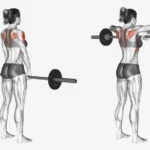Rope Tricep Extension: Exercise Overview
The rope tricep extension is a highly effective isolation exercise that targets the triceps brachii, with a focus on all three heads of the muscle (long, lateral, and medial). Performed using a cable machine with a rope attachment, this variation allows for a natural range of motion and increased muscle activation due to the neutral grip. Strong triceps contribute significantly to pressing movements like the bench press and overhead press, enhancing overall upper-body strength and performance (Schoenfeld, 2010). This exercise is versatile and can be incorporated into tricep-focused workouts, upper-body sessions, push routines, or full-body training programs, making it ideal for both aesthetic and functional goals.
How to Perform the Rope Tricep Extension
- Attach a rope handle to a cable machine, setting the pulley at its highest position.
- Stand with feet shoulder-width apart, grasping the rope with a neutral grip (palms facing each other), and lean slightly forward by hinging at the hips.
- Keep your elbows tucked close to your sides and your upper arms stationary—this is your starting position.
- Extend your elbows to pull the rope downward, flexing your triceps until your arms are nearly straight.
- Pause briefly at the bottom, squeezing your triceps for maximum contraction.
- Slowly return the rope to the starting position with control, allowing your elbows to bend while maintaining tension in the triceps.
- Repeat for the desired number of repetitions.
Tips for Optimal Performance
- Avoid Full Lockout: Stop just short of fully extending your elbows at the bottom to maintain constant tension in the triceps, enhancing muscle activation (Schoenfeld, 2016).
- Keep Elbows Stable: Ensure your elbows remain fixed and close to your body throughout the movement to isolate the triceps and prevent shoulder involvement (McGill, 2010).
- Experiment with Elbow Positioning: For a deeper stretch, allow your elbows to drift slightly behind your body during the eccentric (lowering) phase, similar to a drag curl, but keep the movement controlled.
- Maintain Shoulder Blade Position: Prevent your shoulder blades from tilting forward during the extension to protect your shoulders and maintain proper posture.
- Breathe Properly: Exhale as you extend your arms downward and inhale as you return to the starting position to support controlled movement and muscle oxygenation.
- Adjust Rope Tension: Use a weight that allows you to perform the exercise with proper form for your target rep range (e.g., 10–15 reps for hypertrophy), avoiding excessive resistance that compromises technique.
Sculpting triceps with rope extensions? Discover their role in our Ultimate Guide to Muscle Groups for arm development.







